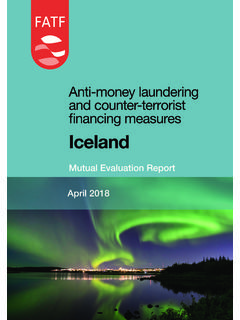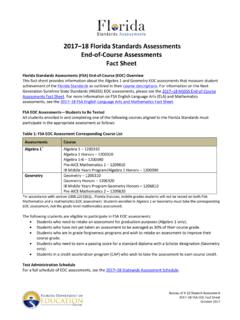Transcription of EFFECTIVE SUPERVISION AND ENFORCEMENT BY …
1 GUIDANCE FOR A RISK-BASED APPROACHEFFECTIVE SUPERVISION AND ENFORCEMENT BY AML/CFT SUPERVISORS OF THE FINANCIAL SECTOR AND LAW ENFORCEMENT OCTOBER 2015 The Financial Action Task Force (FATF) is an independent inter-governmental body that develops and promotes policies to protect the global financial system against money laundering, terrorist financing and the financing of proliferation of weapons of mass destruction. The FATF Recommendations are recognised as the global anti-money laundering (AML) and counter-terrorist financing (CFT) standard. For more information about the FATF, please visit This document and/or any map included herein are without prejudice to the status of or sovereignty over any territory, to the delimitation of international frontiers and boundaries and to the name of any territory, city or area. Citing reference: FATF (2015), Emerging Terrorist Financing Risks, FATF, Paris 2015 FATF/OECD.
2 All rights reserved. No reproduction or translation of this publication may be made without prior written permission. Applications for such permission, for all or part of this publication, should be made to the FATF Secretariat, 2 rue Andr Pascal 75775 Paris Cedex 16, France (fax: +33 1 44 30 61 37 or e-mail: Photocredits coverphoto: Thinkstock EFFECTIVE SUPERVISION AND ENFORCEMENT BY AML/CFT SUPERVISORS OF THE FINANCIAL SECTOR AND LAW ENFORCEMENT GUIDANCE FOR A RISK-BASED APPROACH 2015 1 TABLE OF CONTENTS ACRONYMS .. 2 I. OBJECTIVES AND SCOPE .. 3 II. FINANCIAL SUPERVISION MODELS .. 5 III. BASIS OF AN EFFECTIVE SUPERVISORY 8 A. Market Entry .. 8 B. understanding the ML/TF risks .. 11 C. SUPERVISION and monitoring to mitigate ML/TF risks .. 12 D. Remedial actions and sanctions .. 18 E. Effect of supervisory actions on compliance .. 29 F. Promoting a clear understanding of AML/CFT obligations and ML/TF risks .. 30 IV. COMPLEMENTARY PROCESSES AND ACTIONS AVAILABLE TO LAW ENFORCEMENT .)
3 35 A. Law ENFORCEMENT Mechanisms .. 35 B. Cooperation and Coordination .. 39 C. Law ENFORCEMENT Sanctions .. 42 V. GRAPHIC OVERVIEW OF THESE ELEMENTS .. 43 BIBLIOGRAPHIE AND REFERENCES .. 44 GLOSSARY .. 45 EFFECTIVE SUPERVISION AND ENFORCEMENT BY AML/CFT SUPERVISORS OF THE FINANCIAL SECTOR AND LAW ENFORCEMENT GUIDANCE FOR A RISK-BASED APPROACH 2 2015 ACRONYMS ACPR Autorit de contr le prudentiel et de r solution AML/CFT anti-money laundering and countering financing of terrorism CDD customer due diligence CNBV National Banking and Securities Commission DNFBP designated non-financial businesses and professions FCA Financial Conduct Authority FCA Financial Conduct Authority FINTRAC Financial Transactions and Reports Analysis Centre of Canada FIU Financial intelligence unit FRFI federally regulated financial institutions FSA Financial Services Authority HMRC HM Revenue and Customs IAIS International Association of Insurance Supervisors IOSCO International Organisation of Securities Commission ML money laundering MSB money service business OFAC Office of Foreign Assets Control OSFI Office of the Superintendent of Financial Institutions
4 RBA risk-based approach SAR suspicious activity report STR suspicious transaction report TF terrorist financing TFS targeted financial sanctions EFFECTIVE SUPERVISION AND ENFORCEMENT BY AML/CFT SUPERVISORS OF THE FINANCIAL SECTOR AND LAW ENFORCEMENT GUIDANCE FOR A RISK-BASED APPROACH 2015 3 I. OBJECTIVES AND SCOPE 1. The objective of this non-binding guidance paper is to describe the features of an EFFECTIVE supervisory system, with an aim to enhance countries 1 understanding of the relevant FATF requirements by describing good practices and providing illustrative case examples. EFFECTIVE SUPERVISION and ENFORCEMENT is an important component of an EFFECTIVE anti-money laundering and countering financing of terrorism (AML/CFT) regime. For the purposes of this paper, an EFFECTIVE supervisory and ENFORCEMENT system comprises a wide range of financial supervisory measures that include preventive measures and related sanctions2 and other remedial actions3 that AML/CFT supervisors4 (including regulators) can apply, as well as separate yet complementary measures and actions by law ENFORCEMENT and/or other relevant competent authorities.
5 The overall effectiveness of a country s AML/CFT regime requires recognition of the important synergies that exist between AML/CFT, prudential and business conduct SUPERVISION and between those supervisors and judicial/law ENFORCEMENT authorities. The recognition of this complementarity, as well as the willingness and ability to promote and encourage its application, can only further improve efforts to prevent and combat money laundering (ML)/terrorist financing (TF) in countries. 2. The practices described in this document are intended to serve as examples of the measures and means that relevant supervisors in countries may use to meet the requirement of the FATF Recommendations regarding a supervisory approach. This guidance does not pre-judge the institutional measures and other means that countries may use to achieve risk-based SUPERVISION and ENFORCEMENT in their country, which vary according to each country s context, such as the size and complexity of the financial services sector and the degree of ML/TF risks (including threats and vulnerabilities) to which it is exposed5.
6 As Recommendation 1 recognises that not all financial 1 All references in this paper to country or countries apply equally to territories or jurisdictions. 2 Examples of types of sanctions include: written warnings; orders to comply with specific instructions (possibly accompanied with daily fines for non-compliance); ordering regular reports from the institution on the measures it is taking; fines for non-compliance; barring individuals from employment within that sector; removing, replacing or restricting the powers of managers, directors, and controlling owners; imposing conservatorship or suspension or withdrawal of the license; or criminal penalties where permitted. 3 Examples of remedial actions are corrective actions such as written agreements, board resolutions/letters, supervisory letters,action plans, timelines, reprimands and fines.
7 4 Throughout this paper, the terms supervisor and AML/CFT supervisor refer to the designated competent authorities or non-public bodies with responsibilities aimed at ensuring compliance by financial institutions with requirements to combat money laundering and terrorist financing. This includes: Core Principles supervisors who carry out supervisory functions that are related to the implementation of the FATF Recommendations, and non-public bodies, including certain types of self-regulatory bodies (as defined in the Glossary to the FATF Recommendations) that have the power to supervise and sanction financial institutions in relation to AML/CFT requirements are empowered by law to exercise the functions they perform, and are supervised by a competent authority in relation to such functions. 5 This guidance is not a standard and is therefore not intended to designate specific actions or arrangements necessary to meet obligations under Recommendations 26, 27, 35 and their respective Interpretative Notes, nor does this guidance pre-empt the technical assessment of these Recommendations or the EFFECTIVE SUPERVISION AND ENFORCEMENT BY AML/CFT SUPERVISORS OF THE FINANCIAL SECTOR AND LAW ENFORCEMENT GUIDANCE FOR A RISK-BASED APPROACH 4 2015 institutions face the same ML/TF risks, there may be different approaches to SUPERVISION for different financial sectors ( , money or value transfer services, securities brokers and depository institutions).
8 An actual assessment of effectiveness of the AML/CFT supervisory system in each country is part of the FATF s mutual evaluation process, where assessors evaluate whether the particular measures, controls, and actions taken by each country produce the desired EFFECTIVE 3. This guidance paper is intended to address AML/CFT SUPERVISION and ENFORCEMENT of preventive measures for financial institutions7 as defined by the FATF and should be read in conjunction with the relevant FATF Guidance Papers on the Risk Based Approach (RBA), such as the 2014 RBA Guidance for the Banking Sector8. Other documents that may assist countries are: Sound Management of Risks Related to Money Laundering and Financing of Terrorism ( Basel Committee, January 2014); Core Principles for EFFECTIVE Banking SUPERVISION ( Basel Committee, September 2012) Core Principles of Securities Regulation (IOSCO, 2015a) Guidance on Credible Deterrence in the ENFORCEMENT of Securities Regulation ( IOSCO, 2015b); and Insurance Core Principles (IAIS, nd) 4.
9 Section II sets out some examples of supervisory models, Section III sets out the features of an EFFECTIVE supervisory system, and Section IV sets out complementary processes and actions available to law ENFORCEMENT . Section V shows a graphic representation of EFFECTIVE SUPERVISION and ENFORCEMENT . 5. For the purpose of this guidance paper, the terms Core Principles, financial group, financial institutions, money or value transfer service (MVTS), and targeted financial sanctions have the same meaning as set out in the General Glossary to the FATF Recommendations. assessment of Immediate Outcome 3. Criteria for assessing technical compliance and effectiveness can be found in the FATF Methodology. 6 Throughout this paper, use of the term should is not meant to infer that measures or actions described in this paper are the only way to achieve EFFECTIVE SUPERVISION and ENFORCEMENT .
10 7 This paper does not address the SUPERVISION and monitoring of designated non-financial businesses and professions (DNFBP). 8 RBA Guidance for the Banking Sector (FATF, 2014). The FATF will also issue the RBA Guidance for Money or Value Transfer Services (MVTS) towards 2016 which updates the 2009 RBA Guidance for Money Service Businesses (MSBs). EFFECTIVE SUPERVISION AND ENFORCEMENT BY AML/CFT SUPERVISORS OF THE FINANCIAL SECTOR AND LAW ENFORCEMENT GUIDANCE FOR A RISK-BASED APPROACH 2015 5 II. FINANCIAL SUPERVISION MODELS 6. There are many different supervisory approaches and while the FATF does not prescribe a particular supervisory model, whichever supervisory system is chosen, it should effectively address and mitigate the money laundering and terrorist financing risks in the financial sector. The basic requirements that countries should comply with are in Recommendation 1 (assessing risks and applying risk-based approach), Recommendations 26 (regulation and SUPERVISION of financial institutions), Recommendation 27 (powers of supervisors), Recommendation 34 (guidance and feedback), Recommendation 35 (sanctions), and Recommendation 40 (other forms of international cooperation), as well as Recommendation 2 (National cooperation and coordination).















